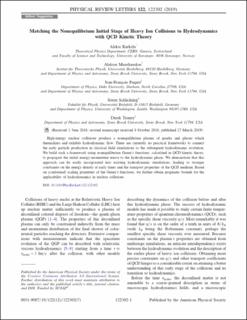| dc.contributor.author | Kurkela, Aleksi | |
| dc.contributor.author | Mazeliauskas, Aleksas | |
| dc.contributor.author | Paquet, Jean-Francois | |
| dc.contributor.author | Schlichting, Sören | |
| dc.contributor.author | Teaney, Derek | |
| dc.date.accessioned | 2021-05-10T07:24:27Z | |
| dc.date.available | 2021-05-10T07:24:27Z | |
| dc.date.created | 2019-07-25T12:51:03Z | |
| dc.date.issued | 2019-03 | |
| dc.identifier.citation | Kurkela, A., Mazeliauskas, J.F.P. et al. (2019) Matching the Nonequilibrium Initial Stage of Heavy Ion Collisions to Hydrodynamics with QCD Kinetic Theory Physical Review Letters, 122 (12) | en_US |
| dc.identifier.issn | 0031-9007 | |
| dc.identifier.uri | https://hdl.handle.net/11250/2754481 | |
| dc.description.abstract | High-energy nuclear collisions produce a nonequilibrium plasma of quarks and gluons which thermalizes and exhibits hydrodynamic flow. There are currently no practical frameworks to connect the early particle production in classical field simulations to the subsequent hydrodynamic evolution. We build such a framework using nonequilibrium Green’s functions, calculated in QCD kinetic theory, to propagate the initial energy-momentum tensor to the hydrodynamic phase. We demonstrate that this approach can be easily incorporated into existing hydrodynamic simulations, leading to stronger constraints on the energy density at early times and the transport properties of the QCD medium. Based on (conformal) scaling properties of the Green’s functions, we further obtain pragmatic bounds for the applicability of hydrodynamics in nuclear collisions. | en_US |
| dc.language.iso | eng | en_US |
| dc.publisher | American Physical Society | en_US |
| dc.rights | Navngivelse 4.0 Internasjonal | * |
| dc.rights.uri | http://creativecommons.org/licenses/by/4.0/deed.no | * |
| dc.subject | fysikk | en_US |
| dc.title | Matching the Nonequilibrium Initial Stage of Heavy Ion Collisions to Hydrodynamics with QCD Kinetic Theory | en_US |
| dc.type | Peer reviewed | en_US |
| dc.type | Journal article | en_US |
| dc.description.version | publishedVersion | en_US |
| dc.subject.nsi | VDP::Matematikk og Naturvitenskap: 400::Fysikk: 430 | en_US |
| dc.source.volume | 122 | en_US |
| dc.source.journal | Physical Review Letters | en_US |
| dc.source.issue | 12 | en_US |
| dc.identifier.doi | 10.1103/PhysRevLett.122.122302 | |
| dc.identifier.cristin | 1712697 | |
| dc.source.articlenumber | 122302 | en_US |
| cristin.ispublished | true | |
| cristin.fulltext | original | |
| cristin.qualitycode | 2 | |

